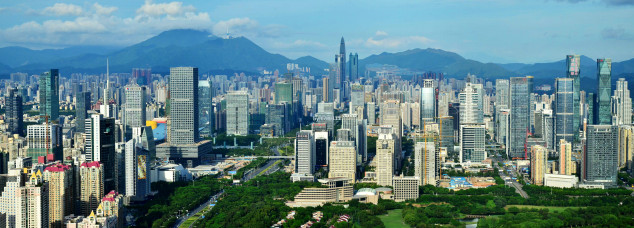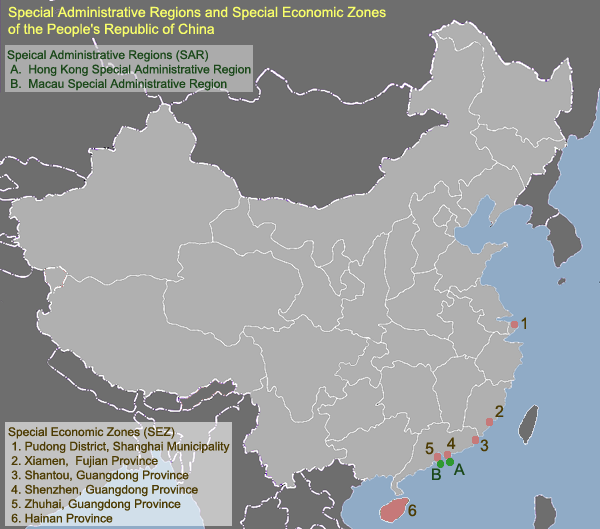I have at last visited Shenzhen, one of China’s four first tier cities (along with Beijing, Shanghai and Shenzhen’s neighbour Guangzhou), as part of the Cambridge EMBA International Business Study Trip. It’s a likeable and impressive city, much greener and cleaner than Beijing and less crowded than Shanghai. It’s also the centre of the Chinese economic miracle, and home to many of China’s leading companies such as Huawei, BYD and Vanke. The EMBAs visited the last two of these, which are in battery and electric cars and real estate respectively.
The story of Shenzhen is often told. In 1980 it was just a fishing village (but one with 300,000 inhabitants – that’s a lot of fish) and now it’s a city of around 12 million, much larger than its neighbour and key business partner, Hong Kong. Shenzhen was chosen as one of the earliest special economic zones (SEZ) by which the Chinese government hoped to stimulate growth. It was wildly successful, tapping into Hong Kong capital and business knowledge and harnessing the ancient trading culture of southern China. The SEZs were designed to provide a low-regulation area in which foreign investors could tap the then-cheap labour of China. That phase of development has been replaced by a much more sophisticated economy, including many high technology companies and a complex system of business providing a vast range of goods and services. Mere low cost assembly work has migrated either to inner China where labour costs remain low or to Cambodia and Vietnam.
Shenzhen also has great political symbolism in China. In 1992, Deng Xiaoping, officially retired and politically weakened by the Tiananmen Square protests of 1989, but still widely regarded as China’s paramount leader, made a tour of southern China, including the newly booming Shenzhen, as part of his ultimately successful attempt to keep the country on the path of economic modernisation. It was on this trip that he may (or may not – it is disputed) have said that “to get rich is glorious”.
China’s current President Xi Jinping made Shenzhen the site of his first official trip away from Beijing after he was chosen as leader in 2012, in what was seen as a clear echo of, and tribute to, Deng’s visit 20 years before. Mr Xi’s father was appointed governor of the province of Guangdong, in which Shenzhen lies, by Deng himself.
Shenzhen’s economic freedom seems to coincide with a degree of political freedom, at least in the way that people think. The people I met in Shenzhen seemed more easygoing than their Beijing counterparts, even the Vice Mayor, who came to the Cambridge-Bejing forum on Shenzhen as a role model for the further expansion of market forces in the Chinese economy. A proverb that gets quoted a lot is that “the mountains are high and the Emperor is far away”. The meaning is that Beijing has limited power over distant provinces, which has always been particularly true of the relatively wealthy south, some 2,000 km from the capital. Most of the original SEZs are in the south of China, three (including Shenzhen) in Guangdong province, located around the Pearl River and next to Hong and Macau. The political implication of this proverb is that Beijing, having granted economic freedom, may struggle to keep control of this mostly Cantonese speaking region (though in Shenzhen most people, being migrants from the rest of China, speak Mandarin).
The stockmarket: not yet achieving its potential
Shenzhen is a secondary financial centre after Shanghai. Locally people would like it be more but central government policy has favoured Shanghai. But the local city government provides support for financial services and the Shenzhen stockmarket is an important source of capital for new companies. Or at least it should be. A year long hiatus in IPOs was ended only in January and there are said to be several hundred companies in the queue. Many of them are companies with private equity investments that are desparately seeking an exit. Private equity in China has been based on a minority stake model where IPO is the only realistic exit route. There is little by way of a secondary market and trade sales are complicated. So many Chinese PE firms are showing internal rates of return that depend on marking to a non-existent market.
The stockmarket IPO freeze arose from the widespread distrust in China of the listed companies’ disclosure and business quality. New IPO candidates must get the securities firms to guarantee their quality, which puts a great risk on the brokers. Pricing of IPOs is still only partly driven by market forces and the whole system falls short of a dynamic capital raising mechanism for fast growing companies.
Shenzhen represents one arm, the private sector one, of the Chinese growth machine. The other is the state-driven investment model based in Beijing. The state owned banks, with funds from high saving Chinese households lacking much of an alternative home for their money, lent at low rates to state owned enterprises and local governments. Both of these have invested heavily in both manufacturing capacity and infrastructure. But much of the investment is of doubtful quality, which means the banks’ loans are at risk too.
The officially stated policy goal is to allow a greater role for market forces. The private sector is already a majority part of the economy, despite being starved of funding by the banks. But this policy shift must mean fewer resources for the politically well connected state sector so there are many vested interests ready to block change. Whereas foreign visitors to China seem ready to take the government’s policy at its word, I was struck again on this trip by the scepticism of the Chinese I spoke to, who have heard similar pronouncements before.
The future: merger with Hong Kong?
There are several large cities in southern China, including Hong Kong, which are already highly integrated economically and physically. Hong Kong retains special status until the deal signed with the UK expires in 2047. But a lot could happen before then. Although outright democracy seems unlikely in mainland China, there has already been some convergence in living standards between Shenzhen, which has one of the highest incomes per head in China, and Hong Kong. Daily travel between the two is fast and easy. A large fraction of property investment in Hong Kong is from the mainland, legally or otherwise. The luxury watch shops of Causeway Bay do a roaring trade, including providing refunds (in Hong Kong dollars) to mainland Chinese who bought their watches in mainland China (paying in RMB), thus facilitating the illegal export of funds.
Shenzhen has aspirations to be the location for Asian and even global headquarters for foreign companies. It is building tall office blocks that will, eventually, rival Hong Kong’s skyline, though Hong Kong will I think remain one of the most spectacular human made places on earth, the only real rival to Manhattan. A building under construction for the Ping An insurance company will be the tallest in Asia and second tallest after the Birj Khalifa in Dubai. That sort of record doesn’t stand for long these days but it’s quite likely that the next most tall building will also be in Shenzhen. So Shenzhen and Hong Kong are both rivals and closely dependent on each other. It is easy to see how continuing growth in Shenzhen will lead to a single de facto integrated megacity.
This prospect apparently still alarms some people in Hong Kong who are fighting to get the full participation promised in the Basic Law that followed Hong Kong’s return to China after British rule. There are frequent demonstrations on this subject. Many Hong Kong residents, quite a few of whom can trace their ancestry back to people fleeing the Communist revolution, are distrustful of Beijing and the Chinese Communist Party. But they also want to continue making money, not least to afford the very high cost of property. The best chance of that is to keep getting closer to the economic powerhouse over the border.




Leave a Reply